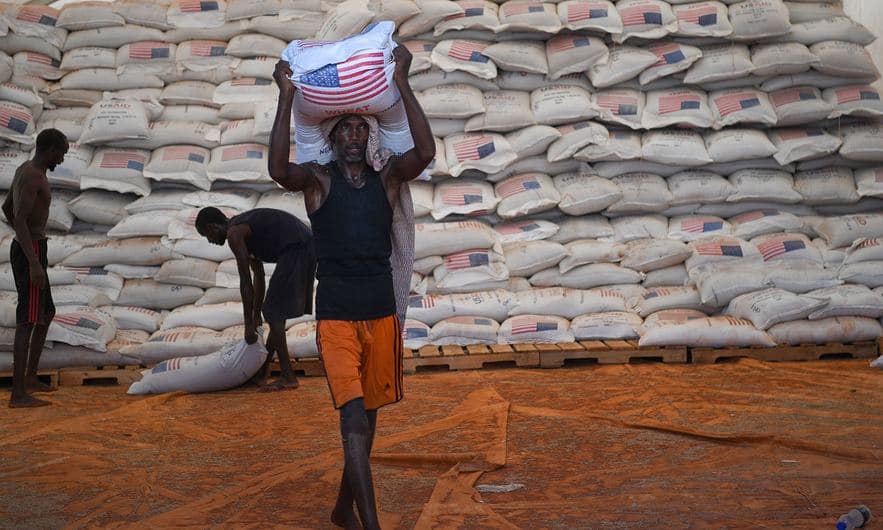Climate, armed conflict, high food prices and post-COVID-19 economic fall-out have caused record food insecurity in the Horn of Africa, with an estimated 60 million urgently in need of help, UN humanitarian agencies warned on Monday.
“About five million children under the age of five are estimated to be facing acute malnutrition in 2023 in the Horn region, in the Greater Horn. That is about 10.4 million, that is just a staggering figure,” said Liesbeth Aelbrecht, the World Health Organization’s (WHO) incident manager for the greater Horn of Africa emergency.
Three year high
“What our colleagues are seeing in clinics and in hospitals, since the beginning of this year, are the highest level of severely malnourished children who are now coming to these facilities with medical complications since the crisis began three years ago.”
Echoing that alert, World Food Programme (WFP) Senior Emergency Officer Dominique Ferretti said that almost three years of drought had given way to rains and devastating flash floods: “While we just concluded a rainy season which performed better than predicted, one rainy season is not enough to bring an end to the crisis.”

Although long-awaited rains arrived in March across the eight-member Intergovernmental Authority on Development (IGAD) region – encompassing Djibouti, Eritrea, Ethiopia, Kenya, Somalia, South Sudan, Sudan and Uganda – and with it the hope of relief, flash-flooding inundated homes and farmland, washed away livestock and closed schools and health facilities.
The result was the highest number of reported disease outbreaks in the greater Horn of Africa so far this century. Their frequency can be linked directly to extreme climate events, according to the UN health agency.
Ms. Aelbrecht noted ongoing outbreaks of cholera and measles, together with “very high numbers” last year and this year, including malaria cases.
“So, with the impact of flooding, we see these diseases worsening. Malaria, I would like to remind you, is one of the biggest killers in the region.”
Climate complications
Climate concerns are key to food security in the coming months, the UN Food and Agriculture Agency (FAO) noted at a press conference in Geneva.
Ecosystem-based adaptation solutions are at the heart of our #ClimateChange work.
In the Horn of Africa, see how women are beating drought through these stories of resilience from Ethiopia and Somalia. https://t.co/ukTJ1XjU1r pic.twitter.com/ITRqDx5ukq
— UN Development (@UNDP) June 26, 2023
Global forecasts indicate that El Niño weather pattern conditions are already present and will strengthen through the rest of the year, which could bring above-average rains during the October to December rainy season across eastern parts of the region, including much of Kenya, the Somali region of Ethiopia and Somalia.
“El Niño may somewhat reduce the risk of flooding in flood-prone areas such as South Sudan,” said Brenda Lazarus, Food Security and Early Warning Economist at FAO’s Subregional Office for Eastern Africa.
Nevertheless, she indicated that “on the risk’ side, below-average rains and dry spells, along with other drivers of food insecurity would likely negatively impact agricultural production and increase already alarming levels.
Investing is key
FAO emphasized the need to shift from a system focused mainly on emergency response, to anticipating and mitigating crises through investments such as in rainwater harvesting, soil and water conservation, or the use of more drought tolerant crops – and ensuring seeds are locally available.
Involving young people in building silos could also boost community resilience, the UN agency noted.
The 60 million severely food insecure include more than 15 million women of reproductive age, 5.6 million adolescent girls and close to 1.1 million pregnant women.
Close to 360,000 of them are expected to give birth in the next three months, according to the United Nations Population Fund (UNFPA).
Women who are forced to look for food just to survive “do so on the expense of their own health,” said Michael Ebele, UNFPA Regional Humanitarian Adviser for East and Southern Africa.
Increased risk of deaths
“So, we are seeing pregnant women not being able to go for antenatal care, not attending to other illnesses they may be having. And then, that comes with risks of complications…then the risks of maternal deaths increase.”
Malnutrition among pregnant and lactating mothers puts their unborn and breast-feeding children at risk of malnutrition and propagates malnutrition through entire life cycles in communities.
Malnourished mothers are also less able to withstand complications in pregnancy which put them at greater risk of losing their child.
“Because of the limited amount of resources, we have seen an increase in the risks of survival sex”, said Ms. Ebele, “increasing the risk of sexual exploitation and abuse, particularly of women and girls”.
Grain initiative threat
Asked by journalists how badly the Horn of Africa would be affected if the UN-brokered Black Sea Initiative to facilitate Ukrainian grain exports to the world’s markets is not renewed next month, WFP’s Mr. Ferretti replied that “the reality is that Ukraine is the breadbasket, it is a major supplier and it would hit us hard if this Black Sea initiative was not renewed”.
